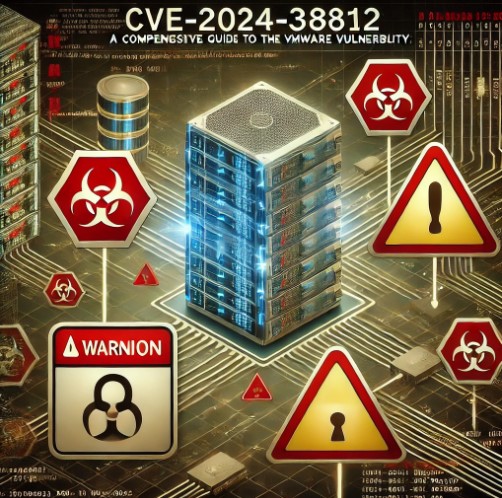Table of Contents
Introduction
In today’s evolving digital landscape, cybersecurity vulnerabilities can create serious disruptions to both organizations and individuals. One such vulnerability, CVE-2024-38812, targets VMware systems and poses significant risks to businesses reliant on this platform. Understanding CVE-2024-38812, its implications, and mitigation strategies is crucial for IT professionals, network administrators, and security teams.
In this article, we’ll break down the technical aspects of this vulnerability, provide real-world examples, and outline methods to secure your systems effectively.
What is CVE-2024-38812?
CVE-2024-38812 Overview
CVE-2024-38812 is a critical security vulnerability identified in VMware systems, specifically targeting the virtual environment and allowing attackers to exploit weaknesses in the system. This vulnerability could enable unauthorized access, data breaches, or system control.
The vulnerability has been rated 9.8 on the CVSS (Common Vulnerability Scoring System) scale, making it a severe issue that demands immediate attention. Affected products may include VMware ESXi, VMware Workstation, and VMware Fusion.
How Does CVE-2024-38812 Work?
Exploitation Path
CVE-2024-38812 is a remote code execution (RCE) vulnerability. An attacker can exploit this flaw by sending specially crafted requests to the VMware system. Upon successful exploitation, the attacker can gain access to critical areas of the virtualized environment, including the ability to:
• Execute arbitrary code on the host machine.
• Access and exfiltrate sensitive data.
• Escalate privileges and gain root or administrative access.
Affected VMware Products
The following VMware products have been identified as vulnerable:
• VMware ESXi versions 7.0.x and 8.0.x
• VMware Workstation Pro 16.x
• VMware Fusion 12.x
It’s essential to keep up-to-date with VMware’s advisories for the latest patches and product updates.
Why is CVE-2024-38812 Dangerous?
Potential Impacts
The nature of remote code execution makes CVE-2024-38812 particularly dangerous for enterprise environments that rely on VMware’s virtualization technology. Exploiting this vulnerability can result in:
• Data breaches: Sensitive corporate or personal data could be compromised.
• System downtime: Attackers could cause significant operational disruptions, leading to service downtime or financial loss.
• Ransomware attacks: Unauthorized access could facilitate ransomware attacks, where malicious actors lock crucial data behind encryption and demand payment for its release.
How to Mitigate CVE-2024-38812
Patching Your Systems
The most effective way to mitigate the risks associated with CVE-2024-38812 is to apply patches provided by VMware. Regularly updating your VMware products ensures that your system is protected from the latest vulnerabilities.
1. Check for patches: VMware releases security patches and advisories on their website. Ensure you are subscribed to notifications for updates.
2. Test patches: Always test patches in a controlled environment before deploying them in production. This ensures compatibility with your existing systems.
3. Deploy promptly: Once tested, deploy patches across all affected systems to minimize exposure to the vulnerability.
Network Segmentation
Limiting network access to VMware hosts can significantly reduce the attack surface. Segmentation ensures that attackers cannot easily move laterally through your network in case of a successful exploit.
1. Restrict access to the management interface using a VPN or a dedicated management VLAN.
2. Implement firewalls and other network controls to isolate sensitive systems.
Regular Security Audits
Conduct regular security audits and penetration testing to identify any potential vulnerabilities that might have been overlooked. These audits should include:
• Vulnerability scanning to detect known vulnerabilities like CVE-2024-38812.
• Penetration testing to simulate potential attacks and assess your system’s resilience.
Frequently Asked Questions (FAQ)
What is CVE-2024-38812?
CVE-2024-38812 is a remote code execution vulnerability in VMware systems, allowing attackers to gain unauthorized access and potentially control affected systems.
How can I tell if my VMware system is vulnerable?
VMware provides a list of affected products in their advisory. You can check your system version and compare it to the advisory. Systems running older, unpatched versions of ESXi, Workstation, or Fusion may be vulnerable.
How do I patch my VMware system?
To patch your system, visit VMware’s official support page, download the relevant security patches, and apply them to your system. Ensure you follow best practices, such as testing patches in a non-production environment before deployment.
What are the risks of not patching CVE-2024-38812?
If left unpatched, CVE-2024-38812 could allow attackers to execute code remotely, access sensitive data, disrupt operations, or deploy malware such as ransomware.
Can network segmentation help mitigate the risk?
Yes, network segmentation is an excellent strategy to limit the attack surface by restricting access to critical parts of your infrastructure. Use VPNs and firewalls to isolate sensitive areas.
Real-World Examples of VMware Vulnerabilities
While CVE-2024-38812 is a new vulnerability, past VMware vulnerabilities such as CVE-2021-21985 and CVE-2020-4006 highlight the risks of leaving VMware systems unpatched. In both cases, attackers exploited VMware vulnerabilities to gain unauthorized access and compromise corporate networks.
In 2021, CVE-2021-21985, another remote code execution vulnerability in VMware vCenter, was actively exploited in the wild before patches were applied. Organizations that delayed patching faced data breaches and system disruptions.
These examples underscore the importance of promptly addressing CVE-2024-38812 by applying patches and maintaining good security hygiene.
Best Practices for Securing VMware Environments
1. Regular Patching and Updates
• Regularly apply patches and updates from VMware.
• Automate patch management if possible to minimize delays in securing your infrastructure.
2. Use Multi-Factor Authentication (MFA)
• Implement multi-factor authentication (MFA) to strengthen access controls.
• MFA can prevent attackers from gaining access even if credentials are compromised.
3. Implement Logging and Monitoring
• Enable detailed logging for VMware systems.
• Use monitoring tools to detect suspicious activity, such as unauthorized access attempts or changes in system behavior.
4. Backup Critical Systems
• Regularly back up virtual machines and data to ensure minimal downtime in case of a breach or ransomware attack.
• Ensure backups are stored securely and offline where possible.
External Links
• National Vulnerability Database (NVD) – CVE-2024-38812
• VMware Official Patches and Updates

Conclusion
CVE-2024-38812 is a serious vulnerability that can have far-reaching consequences if left unaddressed. As with any security threat, prevention is always better than cure. By patching systems, enforcing best practices like MFA, and conducting regular security audits, organizations can significantly reduce the risk of falling victim to this vulnerability.
Always stay vigilant by keeping your systems up-to-date and monitoring for any unusual activity that could indicate a breach. If CVE-2024-38812 is relevant to your environment, act now to protect your systems and data from potentially devastating attacks.
This article provides a clear understanding of the VMware vulnerability CVE-2024-38812 and emphasizes actionable steps to mitigate risks. Properly managing and securing your VMware environment is crucial for maintaining a secure and resilient infrastructure. Thank you for reading the DevopsRoles page!
